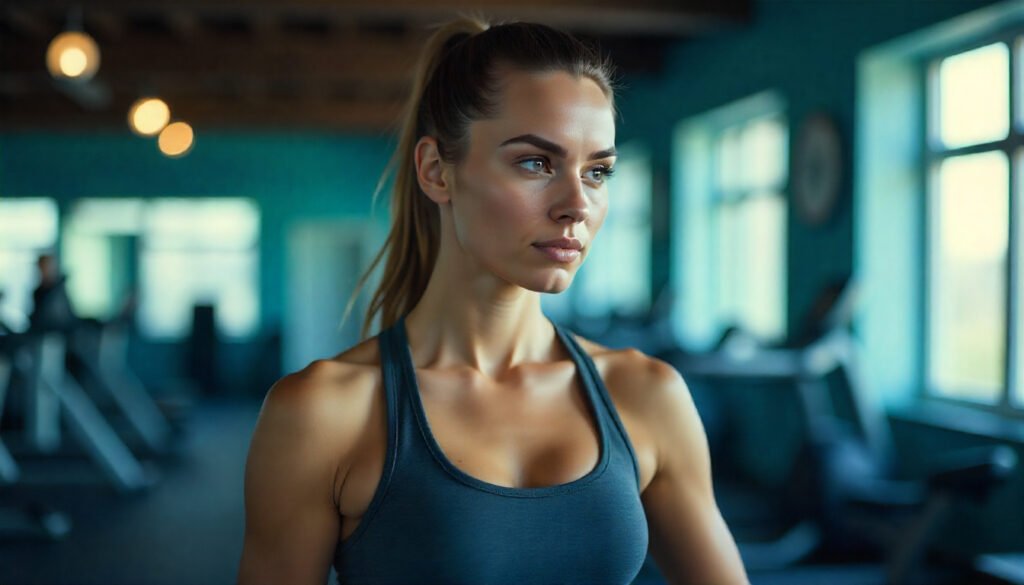It’s easy to obsess over the right shoes, the perfect leggings, or the smartest fitness tracker — but there’s one piece of workout gear that too often gets overlooked: the sports bra. And not just any sports bra — one that actually fits properly.
So, why is wearing a properly fitted sports bra important?
Because it’s not just about comfort — it’s about preventing pain, protecting breast tissue, improving posture, enhancing performance, and even helping you breathe better during exercise. Whether you’re logging miles on the treadmill or powering through a HIIT session, the support (or lack thereof) can make or break your workout.
This isn’t guesswork or gym folklore. These claims are backed by a range of credible sources — from the University of Portsmouth and Nationwide Children’s Hospital to industry leaders like Les Mills and Squatwolf — all pointing to the same truth: the right sports bra isn’t a luxury, it’s a necessity.
The Mechanics of Movement: Why Breasts Need Support
Breasts are composed primarily of glandular tissue and fat, supported by delicate connective fibers known as Cooper’s ligaments. These ligaments, unlike muscles, offer no active control or resistance — meaning the breast has no built-in support system during physical activity.
When you run, jump, or even walk briskly, your breasts move in a figure-eight pattern, with motion occurring both vertically and horizontally. This multidirectional movement places immense strain on Cooper’s ligaments, which can stretch and weaken over time. The result? Pain, tenderness, and irreversible sagging — even in younger women or those with smaller busts.
Without proper support, repeated stress can also lead to tissue damage, discomfort during exercise, and a reluctance to engage in physical activity altogether. That’s where a well-fitted sports bra comes in: by minimizing motion through compression and encapsulation, it provides the external support your anatomy can’t. The result is less pain, better protection, and greater confidence in every movement.
Preventing Pain and Long-Term Damage
If you’ve ever felt that sharp ache in your chest after a workout, you’re not imagining it. That’s the strain of your Cooper’s ligaments — the fragile connective tissue holding your breast structure together — taking a literal beating from repeated movement. These ligaments lack elasticity, and once stretched, they don’t bounce back.
During high-impact workouts like running, breasts can move up to 15 cm in multiple directions, according to the University of Portsmouth. That movement isn’t just uncomfortable — it’s damaging. Over time, the result is chronic pain, inflammation, and irreversible sagging.
Wearing a properly fitted sports bra can reduce breast movement by up to 50-60%. This dramatically lowers the strain on internal tissue, relieving discomfort instantly and preserving the long-term integrity of your breast structure. It’s not just about managing pain in the moment — it’s about preventing permanent damage that accumulates silently, workout after workout.
Keeping Your Shape: How Support Maintains Form
Breast sagging isn’t just a cosmetic concern — it’s often the visible result of unsupported movement over time. Without proper support, every bounce and stretch during exercise puts pressure on the Cooper’s ligaments, causing them to elongate and weaken. Once those internal fibers lose their elasticity, breast shape begins to change, often permanently.
That’s where a well-designed sports bra steps in. The best options use a combination of encapsulation (supporting each breast individually) and compression (holding everything close to the chest wall). Together, these mechanisms minimize motion, reduce tissue strain, and help maintain the natural contour of the breasts — even through years of high-impact workouts.
The truth? Sagging isn’t inevitable. With consistent support from a properly fitted sports bra, you can preserve your shape and protect your breast health long-term.
Posture Matters: Back Support and Spinal Alignment
Breast weight isn’t just a front-loaded issue — it affects your entire upper body, especially your spine. Without adequate support, the weight of the breasts can pull the shoulders forward, leading to a hunched posture, neck tension, and chronic upper-back strain. This misalignment doesn’t just cause discomfort; it can also throw off your balance and reduce the efficiency of your movement during exercise.
For women with larger breasts, this strain is even more pronounced. During high-impact sports like running, jumping, or circuit training, unsupported weight causes the body to overcompensate, resulting in poor form, restricted movement, and increased fatigue. A well-fitted sports bra works to redistribute breast weight evenly across the chest and shoulders, keeping the spine aligned and minimizing muscle fatigue.
And here’s the often-overlooked benefit: posture doesn’t just affect how your body feels — it transforms how you carry yourself. Standing tall, shoulders back, and chest supported doesn’t just improve biomechanics — it amplifies confidence, both in the gym and beyond.
Comfort Is Power: Material, Fit, and Breathability
A sports bra isn’t just about holding things in place — it’s about how it feels against your skin for the entire duration of your workout. The best ones are engineered with moisture-wicking fabrics that pull sweat away from the body, keeping you dry even during high-intensity sessions. Add in breathable mesh panels and 4-way stretch materials, and you’ve got a bra that moves with you, not against you.
But it doesn’t stop at fabric. Adjustable straps, wide bands, and seamless construction help create a snug, customized fit that won’t dig in or rub raw. This is key for avoiding the holy trifecta of discomfort: chafing, irritation, and overheating.
And let’s not forget the mental side of comfort. When your bra fits right and feels right, you’re not fidgeting, shifting, or distracted. You’re focused, grounded, and confident — fully present in your movement. Because real performance starts where comfort begins.
Focus and Performance: How Support Translates to Results
Every bounce, pinch, or adjustment you make during a workout pulls your attention away from what matters: performance. A properly fitted sports bra eliminates that distraction, allowing you to move freely and stay mentally locked in. Whether you’re sprinting, squatting, or smashing out burpees, support equals focus — and focus fuels results.
Studies from the University of Portsmouth found that wearing a well-fitted sports bra can improve running efficiency by up to 7%. That’s not just comfort talking — that’s real, measurable performance gain. Similarly, Les Mills reports that women experience less pain and more freedom of movement during high-intensity training when wearing the right support.
The takeaway? When you’re not distracted by discomfort, you move better, last longer, and train harder. Support isn’t just about holding your body — it’s about unleashing your potential.
Breathing Room: The Right Fit and Fatigue Prevention
A sports bra that’s too tight does more harm than good — especially when it comes to breathing. Compression is important, but over-compression can restrict your ribcage, leading to shallow breathing and faster fatigue during workouts. When your lungs can’t fully expand, your muscles don’t get the oxygen they need, and that means less stamina, lower performance, and early burnout.
The solution? A properly fitted sports bra that offers firm support without squeezing the life out of you. It should feel secure but still allow you to take a deep breath without resistance.
Quick fit check: Inhale deeply — if the band digs in or feels restrictive across your ribs, it’s too tight. You should be able to slide two fingers comfortably under the band without struggling.
Your breath is your power source. Don’t let your bra shut it down.
The Longevity Factor: Protecting Ligaments for Life
Every time you skip proper support during exercise, your breast tissue pays a price — often silently. The repetitive stress of motion, especially during high-impact workouts, gradually wears down the Cooper’s ligaments that support breast shape. These ligaments don’t heal or “bounce back” once stretched — meaning the damage is cumulative and permanent.
Wearing a well-fitted sports bra during every workout isn’t just about comfort today — it’s an investment in long-term breast health. By minimizing bounce and strain, you’re actively preserving the integrity of your breast tissue, preventing chronic pain, sagging, and posture issues later in life.
This protection is especially critical during high-movement life stages like puberty, pregnancy, and postpartum, when hormonal shifts and breast changes increase vulnerability. In these windows, proper support isn’t optional — it’s essential.
Conclusion
Wearing a properly fitted sports bra isn’t just a fitness upgrade — it’s a form of self-care. It reduces breast movement and pain, protects delicate tissue from long-term damage, improves posture, enhances comfort, boosts performance, and allows for better breathing.
This isn’t just about how you look in the mirror — it’s about how you feel, how you move, and how you show up for your body. Support equals strength, and the right bra delivers both.
Get professionally fitted, choose a style that suits your workout intensity, and invest in gear that works as hard as you do. Because your body deserves nothing less.
FAQs
- Why is a properly fitted sports bra important for exercise?
A proper fit minimizes breast movement, prevents pain, and supports long-term breast health during physical activity. - What happens if I don’t wear a sports bra while working out?
Skipping support can lead to tissue damage, sagging, discomfort, and even back or posture issues over time. - How do I know if my sports bra fits correctly?
A good fit should feel snug but not tight, with no digging, gaping, or chafing. You should be able to breathe deeply and move freely. - Can wearing the wrong sports bra affect my performance?
Yes — poor support can cause discomfort and distraction, reducing focus, energy, and overall performance during workouts. - Is it OK to wear a sports bra all day?
If it’s well-fitted and made of breathable materials, yes. But avoid overly tight bras for long wear to prevent skin irritation or restricted breathing. - Should I wear different bras for low- and high-impact workouts?
Absolutely. Choose light support for yoga or walking, and opt for high-impact bras for running, HIIT, or cardio. - How often should I replace my sports bra?
Every 6–12 months, depending on how often you use it. Stretching, worn-out fabric, or lack of support are signs it’s time to replace.
What features should I look for in a good sports bra?
Moisture-wicking fabric, adjustable straps, wide band, proper cup separation, and enough compression or encapsulation for your activity level.

